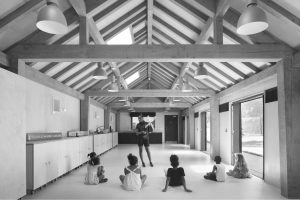Cite this article
(2022) ‘Scale of community centre: Clarification of the relation between scale and multifunctionality of community buildings’, Architecture Papers of the Faculty of Architecture and Design STU, 26(3), pp. 24-32. https://www.doi.org/10.2478/alfa-2021-0016
SUMMARY
Community architecture is gaining popularity for its potential to encourage community interaction and strengthen community ties. It is becoming a contributing tool for community development. Community architecture represents not only the final product of architectural design but also the design process. It covers many kinds of community interventions and efforts of different extent; from tiny public space interventions and neighbourhood projects to a complex design of community centres or designing comprehensive urbanistic structures focused on community well-being. No matter the scale, the goal is the same: to provide space for leisure activities, networking, and reinforcing a sense of community.
The community centre can be perceived as the most apparent design concept representing community architecture. The design considers design approach, relationship towards users and their involvement in the design, urbanistic relationships, architectural appearance, materials, spatial and functional requirements, interior design, equipment, and furniture solutions. It provides space for meetings and interaction, and its program derives from the needs of a specific community.
The community architecture theory, along with the community centre typology, is an under-explored phenomenon in Slovakia. Thus, there is a lack of methodical design recommendations or guidelines for such a design. The author’s previous article titled Community Architecture (ALFA 3/2020, pp. 3–12) covers the theoretical background. With listed examples of executed Slovak designs and basic categorization, the paper provided introductory knowledge of community architecture. In turn, the current article focuses on community centres more in detail.
The detailed analysis of implemented designs allows the identification of prevalent features, patterns, and their interrelationships. The article focuses on 100 selected community facilities executed and introduced online in recent ten years (2010-2020). Research is a part of the author’s elaborated dissertation thesis named Community Centres. The presented part of research aims to examine fundamental characteristics of community centres, particularly their multifunctionality related to the character of the space, and the scale related to size in square meters. The article verifies the premise about the direct relationship between scale and multifunctionality. The goal is to endorse this generalized finding while bringing a better understanding of scale categories.
The examination of all characteristics led to two significant findings related to scale, building status, and multifunctionality. Research did not confirm any relationship between the scale and status of the building. However, it verifies the dominance of new community buildings over reconstructions and conversions. According to the results, there is an evident relationship between centres’ scale and multifunctionality supporting the research premise. However, ambiguous data available in relation to one of the scale categories will stimulate further research of the issue. The results suggest new size categories, which clearly describe the relationship between the two mentioned characteristics.
There is a vast potential for multidisciplinary research of community architecture to enhance knowledge of this concept. Methods of participation, community psychology, or neuroarchitecture are mentioned to name a few. The study of 100 executed projects brings a better understanding of the community building concepts. The findings of research may serve as design guidelines for further design practice.


